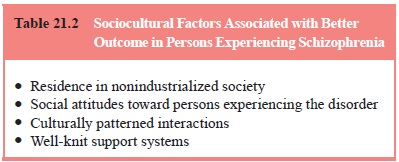Chapter: Essentials of Psychiatry: Cultural Aspects of Psychiatric Disorders
Schizophrenia and Related Psychotic Disorders
Schizophrenia and Related
Psychotic Disorders
The cross-cultural presentation and course of
schizophrenia are among the best-studied aspects of cultural psychiatry.
Research has revealed both cross-cultural similarities and differences, both of
which are important for elucidating the biological and en-vironmental bases of
the disease. A “spectrum’’ of schizophrenic syndromes – consisting of a
combination of certain positive and negative psychotic symptoms – has been
found nearly every-where, although the specific content of hallucinations and
delu-sions as well as the prevalence of visual and other nonauditory
hallucinations varies (Krassoievitch et
al., 1982; Ndetei and Vad-her, 1984). Significant cross-cultural variation
has been found, however, in several features of the syndrome. Its distribution
is not uniform, ranging from 1 in a 1000 in the nonWestern societies to more
than 1% in the West; its highest prevalence is displayed in economically and
technologically advanced, urbanized and bureaucratized societies (Kleinman,
1988; Warner, 1985). Its phenomenology varies with cultural setting, with much
higher rates of catatonia in India and of hebephrenia in Japan than in the
West. Most important, the course and outcome of schizophrenia are markedly
better in nonindustrialized countries, even when cultural differences in
outcome assessment and in acuteness of presentation are taken into account
(Sartorius et al., 1986; Lin and
Kleinman, 1988; Kulhara and Chakrabarti, 2001). Varia-tions in outcome are
thought to be related in part to different attitudes toward persons with the
disorder, a set of culturally pat-terned interactions studied under the rubric
of expressed emotion (Jenkins and Karno, 1992) (Table 21.2). Other
cross-cultural vari-ations with regard to schizophrenia include higher
misdiagnosis among patients from devalued and ethnic minority groups (Good,
1992/93), differences in cultural and gender-related conceptions

regarding the expression of emotion that complicate
the assess-ment of flat affect (Karno and Jenkins, 1997), and culturally
syntonic experiences that may be mistaken for schizophrenic symptoms. The
latter include the accepted appearance of hal-lucinations among the bereaved
Native Americans (Hultkrantz, 1979) or reports of perceptual alterations among
the distressed Puerto Ricans (Guarnaccia et
al., 1992).
Cross-cultural differences have also been detected
in emotional processing among the German, American and Indian subjects with
schizophrenia. Face discrimination performance was most impaired in the Indian
subgroup (Habel et al., 2000).
Another study comparing the German natives and the Turkish immigrants with
schizophrenia also found cross-cultural differ-ences, this time in higher
indices of hostile excitement and de-pression among the immigrant group (Haasen
et al., 2001).
Related Topics